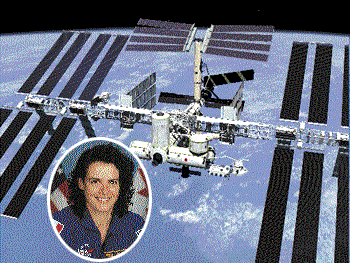Fine feathered fossils
 McGill graduate Philip Currie, MSc'75, PhD'81, made the cover of Time magazine this summer for his discovery of fossils of two new species of dinosaur in China. The unearthing of Protarchaeopteryx and Caudipteryx by Currie and his associates from China and New York is said to effectively prove the evolutionary connection between birds and dinosaurs. McGill graduate Philip Currie, MSc'75, PhD'81, made the cover of Time magazine this summer for his discovery of fossils of two new species of dinosaur in China. The unearthing of Protarchaeopteryx and Caudipteryx by Currie and his associates from China and New York is said to effectively prove the evolutionary connection between birds and dinosaurs.
Currie's dinosaurs have long necks and legs, stubby arms, feathers adorning a long tail, and likely resembled turkeys when they roamed the Earth approximately 145 million years ago. Protarchaeopteryx may be a relative of the 70-million-year-old Velociraptor, the nasty, flesh-eating dinosaur that stalked paleontologists and children in the film Jurassic Park. The second specimen, Caudipteryx, may be even more important, as it had feathers not only on its tail but on its arms as well, suggesting wings. Currie told Time of his initial reaction to the fossils he was shown in Beijing. "My jaw dropped. Not only was it a complete specimen the size of a turkey, but it also had structures along the back that were feather-like. It wasn't mineralized. It wasn't fungus. It was real."
Robert Carroll, professor of zoology at McGill, curator of vertebrate paleontology at the Redpath Museum, and Currie's PhD supervisor, says the specimens "are probably early cretaceous -- though that's a matter of some debate -- which actually places them after the first bird." Despite this, says Carroll, "it's very strong evidence that amongst that group of dinosaurs arose the birds."
Carroll says he and his former student have been working together for some time on a project which examines the links between paleozoic and modern amphibians.
Until recently, Currie was probably most famous as the curator of dinosaurs and one of the founders of the Royal Tyrrell Museum of Paleontology in Drumheller, Alta., an area riddled with dinosaur bones. He is also said to be the model for the paleontologist played by Sam Neill in Jurrassic Park.
|
Alice in Wonderland |
 |  |
| Separated at birth? McGill grad Alice Lehrer, above, and Bette Midler, left. Or is it the other way around... |
Imagine hanging out on a movie set with the likes of John Cleese, Frasier's David Hyde Pierce, Stockard Channing and Nathan Lane. That's how Alice Lehrer, BA'68, spent her summer. You might think it an unlikely place to find Lehrer, a 50-something occupational therapist -- until you see her, that is. The Montreal wife and mother bears a remarkable resemblance to Bette Midler, star of the movie Isn't She Great, which wrapped up filming here in August. Lehrer's looks won her the job of stand-in for the Divine Miss M.
"I laughed a lot, but it was also pretty gruelling," says Lehrer, who regularly put in 14-hour days. "It was fascinating to see first hand what's involved in making a movie. The set is like an enclosed world, a whole society with its own hierarchy and its own vocabulary."
Part of her chores included stunt driving. "Some of it was very tricky. I used to race on the ski team at McGill, and I think that's where I learned to take sharp corners." Lehrer also had to spend a whole night standing in a pond on St. Helen's Island while scenes were shot over and over of Midler's character and her husband having a fight in the water. "Show business is not all glamour," she laughs.
Lehrer says her likeness to Midler goes beyond looks. "We're the same age. She is very much like me, only more expressive and outgoing.
One day, we even arrived on the set wearing identical sweat suits. People found it a little uncanny."
|
Gifts keep on giving
The Development Office reports that since the official close of The McGill Twenty-First Century Fund campaign in May 1996, the total has continued to climb. Some donors increased their contributions and others finalized gifts that were incomplete at the time.
The final tally is now $206,624,000, making McGill's campaign the most successful privately-funded university campaign in Canadian history. Another remarkable result is the rate of realization on pledges -- or the percentage of donors who actually live up to their promise to give. That rate stands at an astonishing 99.25%.
Many of these gifts are already at work. For example, campaign funding has helped put into place 18 new department chairs, 72 scholarships, bursaries and awards, 84 direct-funded fellowships, two institutes, four major buildings and 22 laboratories, units or research projects.
|
Grads in space

It's not every day that a McGill graduate gets launched into space, but it's certainly becoming more common. On the heels of Dave Williams's shuttle mission last April, Julie Payette, BEng'86, received word in July that she will be the next Canadian astronaut to lift off from the Kennedy Space Center in Florida. Payette will climb aboard the space shuttle Atlantis in May 1999, part of the crew who will be assembling a crane for the Russian cargo section of NASA's International Space Station. Payette will also be unloading and testing equipment for the Russian living quarters, and will be the first astronaut to sleep in the service module.
"I was floored. I had to sit down," said the 34-year-old Montreal native about the call from NASA. "I'm not thinking about the actual launch. I'm thinking of whether I can deliver. It's a tremendous responsibility. We don't have any margin for error."
The space station will be an orbiting laboratory the size of a football field that will enable long-term exploration of space and will be visible from Earth.
When she's not preparing for space flight, Payette is a multilingual engineer and pilot, who in her spare time has sung with the Tafelmusik Baroque Orchestra Choir and competed in triathlons.
Meanwhile, Dave Williams, BSc'76, MSc'83, MDCM'83, has been named head of the Space and Life Sciences Directorate at the Johnson Space Center in Houston. The Directorate is the division of NASA that studies the capabilities and limitations of humans living and working in space. Williams conducted dozens such life sciences experiments on the Neurolab mission in April aboard the space shuttle Columbia, and will remain on active flight status as a Canadian astronaut.
|
First-year athletic scholarships KO'd
 The gloves were definitely off at the annual meeting of the Canadian Interuniversity Athletic Union in June. The fight, over approval for athletic scholarships for first-year students, ended in what might turn out to be a split decision. Schools in western Canada were so upset when the motion was defeated that they threatened to start their own association. The gloves were definitely off at the annual meeting of the Canadian Interuniversity Athletic Union in June. The fight, over approval for athletic scholarships for first-year students, ended in what might turn out to be a split decision. Schools in western Canada were so upset when the motion was defeated that they threatened to start their own association.
Opposition came mostly from Ontario schools, which voted as a bloc to defeat the proposal. Bob Dubeau, who represented McGill at the CIAU meeting, thinks the reason is mainly financial. "Ontario universities don't have the funds. They're worried about a program like this becoming a burden."
Quebec universities aren't exactly flush, but, with the exception of Concordia, they voted for the proposal. That reflects their concern with recruiting, says Dubeau, who is Director of Athletics at McGill. "We're losing more and more of Quebec's and Canada's best athletes to the U.S. It's becoming extremely difficult to attract these students to schools in this country."
Canadian universities, except in Ontario, do offer athletic awards after first year, but a student must sit out a whole year if he or she wishes to change schools.
Dubeau thinks approval will come before too long. He recognizes that extra money would have to be found, but says it could be done. "I think we could raise pretty significant dollars for a well-managed, well-controlled awards program for talented athletes who
are also good students. Nobody with a 59% average will be winning a scholarship."
|
|